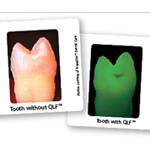
A toothbrush and a string of mint-flavored dental floss are essential to 6-year-old Natalie Hoffmann’s bedtime routine. Ever since she learned about the dangers of the dreaded cavity creep, Natalie makes certain to set aside time each day to brush her teeth. Thanks to Health Science Center husband-and-wife team, Kevin Donly, D.D.S., M.S., professor and chair of pediatric dentistry, and Adriana Segura, D.D.S., M.S., professor of general dentistry, Natalie and other children now have another tool to aid them in their rigorous regimen.
For five years the research team has methodically examined the effects that an innovative dental diagnostic tool has on children’s primary (baby) teeth. They found that Quantitative Light-induced Fluorescence (QLF™) may be the ultimate detector of early caries (decay). Because the fluorescent lighting is directly related to the mineral content of enamel, the light can spot lesions before they progress enough to need invasive treatments such as fillings.
No more than five dentists in the United States are using QLF™ right now, and much of the available data is based on trials Drs. Donly, Segura and associated investigators conducted.
“There is a need for better dental diagnostic techniques so that dentists can avoid invasive dental procedures,” Dr. Donly said. “Instead of waiting until the cavity needs to be filled, QLF™ allows us to see the problem early enough so we can intervene using sealants or fluoride to stop the decay.”
Children ages 6 to 10 participated in the “Early Caries Detection and Intervention” study, which also included the University of Iowa and Indiana University. The study was supported by a grant from the National Institute of Dental and Craniofacial Research.
“It was important that we studied children’s primary teeth so that when early decay was diagnosed, the teeth could be retrieved and then analyzed when they fell out,” Dr. Segura said.

Drs. Donly and Segura performed follow-up examinations with the children every six months, and when the teeth naturally fell out, a microscope was used to examine them. By using this technique, the researchers could verify that what the QLF™ tool showed in the clinic was also valid under the microscope.
QLF™ is a small, portable camera equipped with a blue light that illuminates the teeth and captures images with a yellow filter. The fluorescence of the light on the teeth displays cavities, or lesions, as dark spots. The camera is connected to a computer with exclusive QLF™ software that allows images of the patient’s teeth to be displayed and stored.
Drs. Donly and Segura are in the final stages of their study but have applied for another grant to continue their work. “We feel we have validated the use of QLF™ and want to use it to intervene when a lesion, or early tooth demineralization, is noted,” Dr. Donly said.
“We’re convinced that if the dentist catches the decay early, the tooth demineralization can be inhibited with this early intervention technique,” he said.
Although the study examined children, the researchers said this technique could benefit people of all ages.
“Sixty to 75 percent of all dental work performed is to replace fillings,” Dr. Donly said. “When lesions are detected early, sealants or other minimally invasive procedures can be used to eliminate more decay.”
The work of Drs. Donly and Segura is helping children like Natalie steer clear of the cavity creep, and to see a visit to the dentist’s office in a whole new light.

